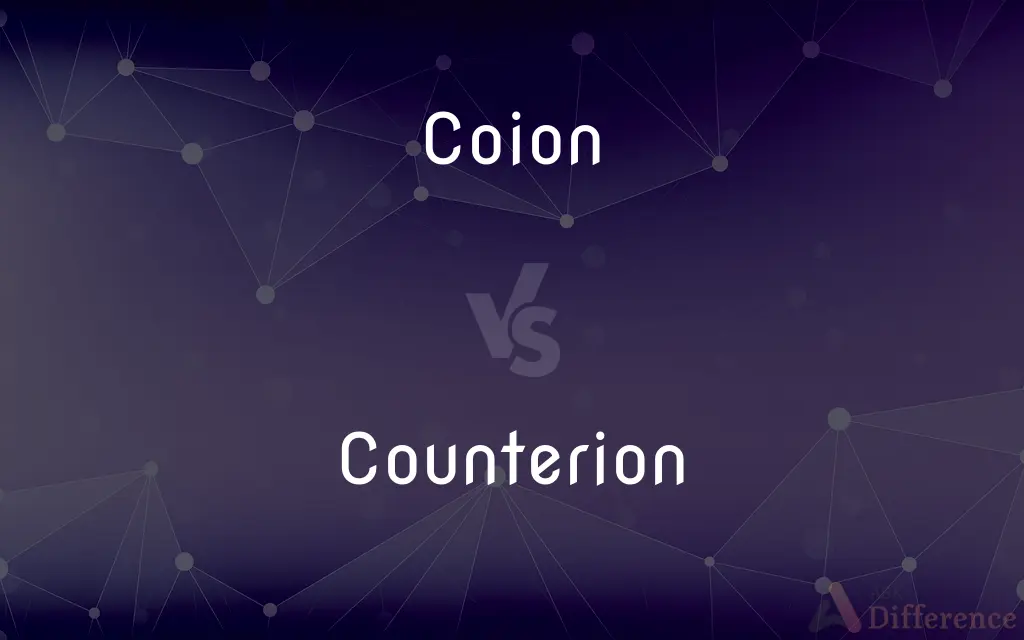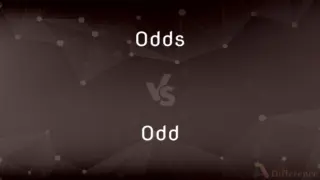Coion vs. Counterion — What's the Difference?
Edited by Tayyaba Rehman — By Fiza Rafique — Updated on April 5, 2024
Coions move in the same direction as like-charged particles during electrophoresis, whereas counterions move oppositely, balancing the charge.

Difference Between Coion and Counterion
Table of Contents
ADVERTISEMENT
Key Differences
Coions and counterions are integral components in the realm of electrochemistry, particularly when discussing ionic solutions and their behavior in electric fields. Coions, as the name suggests, are ions that share the same electrical charge as another ion of interest. In contrast, counterions possess an opposite charge to that of the ion in question, playing a crucial role in maintaining electrical neutrality within a solution.
When an electric field is applied to an ionic solution, coions and counterions exhibit distinct movements due to their charge differences. Coions will tend to move in the same direction as the ions that share their charge, a phenomenon that can affect the distribution of ions across the solution. On the other hand, counterions move in the opposite direction to the ions with which they are associated, which is essential for counterbalancing the charges within the solution and maintaining electrical neutrality.
In processes such as electrophoresis, the behavior of coions and counterions becomes especially significant. Coions may contribute to the background ionic strength of the solution, influencing the mobility of molecules under the electric field. Whereas counterions, by moving in the opposite direction, can significantly affect the effective charge of molecules, thus influencing their migration speed and direction during electrophoresis.
The interaction between coions and counterions also plays a pivotal role in the stability of colloidal systems. Coions can contribute to the repulsion between similarly charged particles, potentially leading to destabilization. Conversely, counterions can enhance the attraction through charge screening, promoting stability within colloidal dispersions.
Understanding the distinction between coions and counterions is crucial for manipulating and predicting the behavior of ions in various chemical and physical processes. These concepts are not only fundamental in electrochemistry but also in fields such as biochemistry and environmental science, where the control of ionic interactions is key to many applications.
ADVERTISEMENT
Comparison Chart
Charge
Same as another specified ion
Opposite to a specified ion
Movement Direction
Moves in the same direction as like-charged ions
Moves in the opposite direction to its associated ion
Role in Electrophoresis
Contributes to background ionic strength
Affects migration speed and direction by charge balancing
Impact on Colloidal Stability
May contribute to repulsion and destabilization
Enhances attraction through charge screening
Significance
Affects ion distribution in electric fields
Crucial for maintaining electrical neutrality
Compare with Definitions
Coion
The presence of coions affects the electrostatic interactions in colloidal systems.
Excess coions can reduce the repulsive forces between like-charged colloidal particles.
Counterion
A counterion is an ion with a charge opposite to that of another ion, helping to maintain electrical neutrality.
In sodium chloride, chloride ions (Cl-) act as counterions to sodium ions (Na+).
Coion
A coion refers to an ion in a solution that has the same electric charge as another ion.
In a solution of sodium chloride, the sodium ion (Na+) is a coion to other cations like potassium (K+).
Counterion
In electrophoresis, counterions can affect the speed and direction of molecule movement.
Counterions can slow down the migration of DNA towards the positive electrode.
Coion
Coions can influence the ionic strength of a solution.
Increasing the concentration of coions raises the solution’s ionic strength.
Counterion
Counterions play a vital role in stabilizing charged molecules.
Counterions surrounding a negatively charged DNA molecule help neutralize its charge.
Coion
Coions move parallel to like-charged ions in an electric field.
During electrophoresis, coions and analyte ions with the same charge move in the same direction.
Counterion
The behavior of counterions is fundamental in ion exchange processes.
Counterions are exchanged in water softening processes to remove calcium and magnesium.
Coion
Coions are critical in the study of electrochemical cells.
Coions participate in the transport of charge in electrolyte solutions.
Counterion
Counterions are essential for the stability of colloidal systems.
Adding counterions can precipitate out colloidal particles by neutralizing their charge.
Coion
(chemistry) Any ion of the same charge as another in a solution or other electrochemical system.
Counterion
A counterion (pronounced as two words, i.e. "counter" "ion", and sometimes written as two words) is the ion that accompanies an ionic species in order to maintain electric neutrality.
Counterion
(chemistry) Any ion of opposite charge to another in a solution or other electrochemical system
Common Curiosities
How do counterions affect colloidal stability?
Counterions can enhance colloidal stability by neutralizing charges and promoting attraction between particles.
What is a counterion?
A counterion is an ion with an opposite charge to another specified ion, crucial for maintaining electrical neutrality.
Why are counterions important in biochemical processes?
Counterions are important in biochemical processes for stabilizing charged molecules and complexes, such as proteins and DNA.
How do counterions participate in ion exchange processes?
Counterions are exchanged with other ions in processes like water softening, to remove undesirable ions from a solution.
What is a coion?
A coion is an ion that has the same charge as another specified ion within a solution.
What is the significance of counterions in DNA stabilization?
Counterions neutralize the negative charge on DNA molecules, allowing them to remain stable and compact.
How do coions and counterions differ in their movement?
Coions move in the same direction as like-charged ions, whereas counterions move oppositely, balancing charges.
What role do coions play in electrophoresis?
Coions contribute to the background ionic strength, affecting the mobility of molecules under an electric field.
What impact do coions have on electrostatic interactions in solutions?
Coions can modify electrostatic interactions, potentially reducing repulsion between like-charged entities in a solution.
How does the movement of coions and counterions differ in an electric field?
Coions move in the same direction as like-charged particles, while counterions move towards the oppositely charged electrode.
Can coions influence the ionic strength of a solution?
Yes, coions directly influence the ionic strength of a solution by contributing to its total ion concentration.
In what way do coions and counterions contribute to the electrical neutrality of a solution?
While coions can increase the concentration of like-charged ions, counterions balance this by providing an opposite charge, together maintaining electrical neutrality.
Are coions always positive ions?
No, coions can be either positive or negative, depending on the charge of the ion they are compared with.
Can the presence of counterions lead to the precipitation of colloidal particles?
Yes, adding counterions can neutralize the charge on colloidal particles, leading to their aggregation and precipitation.
Share Your Discovery

Previous Comparison
Odds vs. Odd
Next Comparison
Maneuvre vs. ManeuverAuthor Spotlight
Written by
Fiza RafiqueFiza Rafique is a skilled content writer at AskDifference.com, where she meticulously refines and enhances written pieces. Drawing from her vast editorial expertise, Fiza ensures clarity, accuracy, and precision in every article. Passionate about language, she continually seeks to elevate the quality of content for readers worldwide.
Edited by
Tayyaba RehmanTayyaba Rehman is a distinguished writer, currently serving as a primary contributor to askdifference.com. As a researcher in semantics and etymology, Tayyaba's passion for the complexity of languages and their distinctions has found a perfect home on the platform. Tayyaba delves into the intricacies of language, distinguishing between commonly confused words and phrases, thereby providing clarity for readers worldwide.















































